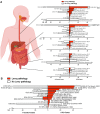Gut-to-Brain α-Synuclein Transmission in Parkinson's Disease: Evidence for Prion-like Mechanisms
- PMID: 37108366
- PMCID: PMC10139032
- DOI: 10.3390/ijms24087205
Gut-to-Brain α-Synuclein Transmission in Parkinson's Disease: Evidence for Prion-like Mechanisms
Abstract
Parkinson's disease (PD) is a multifactorial disorder involving both motor and non-motor symptoms caused by the progressive death of distinct neuronal populations, including dopaminergic neurons in the substantia nigra. The deposition of aggregated α-synuclein protein into Lewy body inclusions is a hallmark of the disorder, and α-synuclein pathology has been found in the enteric nervous system (ENS) of PD patients up to two decades prior to diagnosis. In combination with the high occurrence of gastrointestinal dysfunction in early stages of PD, current evidence strongly suggests that some forms of PD may originate in the gut. In this review, we discuss human studies that support ENS Lewy pathology as a characteristic feature of PD, and present evidence from humans and animal model systems that α-synuclein aggregation may follow a prion-like spreading cascade from enteric neurons, through the vagal nerve, and into the brain. Given the accessibility of the human gut to pharmacologic and dietary interventions, therapeutic strategies aimed at reducing pathological α-synuclein in the gastrointestinal tract hold significant promise for PD treatment.
Keywords: Parkinson’s disease; alpha-synuclein; enteric nervous system; prion-like.
Conflict of interest statement
The authors declare no conflict of interest.
Figures



Similar articles
-
The prion-like spreading of α-synuclein: From in vitro to in vivo models of Parkinson's disease.Ageing Res Rev. 2019 Mar;50:89-101. doi: 10.1016/j.arr.2019.01.012. Epub 2019 Jan 25. Ageing Res Rev. 2019. PMID: 30690184 Review.
-
Prion-like propagation of α-synuclein in the gut-brain axis.Brain Res Bull. 2018 Jun;140:341-346. doi: 10.1016/j.brainresbull.2018.06.002. Epub 2018 Jun 9. Brain Res Bull. 2018. PMID: 29894766 Review.
-
Parkinson's disease from the gut.Brain Res. 2018 Aug 15;1693(Pt B):201-206. doi: 10.1016/j.brainres.2018.01.010. Epub 2018 Jan 31. Brain Res. 2018. PMID: 29360467 Free PMC article. Review.
-
What is the Evidence That Parkinson's Disease is a Prion Disorder, Which Originates in the Gut?Int J Mol Sci. 2018 Nov 12;19(11):3573. doi: 10.3390/ijms19113573. Int J Mol Sci. 2018. PMID: 30424585 Free PMC article. Review.
-
Movement of prion-like α-synuclein along the gut-brain axis in Parkinson's disease: A potential target of curcumin treatment.Eur J Neurosci. 2021 Jul;54(2):4695-4711. doi: 10.1111/ejn.15324. Epub 2021 Jun 23. Eur J Neurosci. 2021. PMID: 34043864 Review.
Cited by
-
Beyond the Microbiota: Understanding the Role of the Enteric Nervous System in Parkinson's Disease from Mice to Human.Biomedicines. 2023 May 27;11(6):1560. doi: 10.3390/biomedicines11061560. Biomedicines. 2023. PMID: 37371655 Free PMC article. Review.
-
The raphe nuclei are the early lesion site of gastric α-synuclein propagation to the substantia nigra.Acta Pharm Sin B. 2024 May;14(5):2057-2076. doi: 10.1016/j.apsb.2024.01.015. Epub 2024 Jan 29. Acta Pharm Sin B. 2024. PMID: 38799632 Free PMC article.
-
Bidirectional communication of the gut-brain axis: new findings in Parkinson's disease and inflammatory bowel disease.Front Neurol. 2024 May 24;15:1407241. doi: 10.3389/fneur.2024.1407241. eCollection 2024. Front Neurol. 2024. PMID: 38854967 Free PMC article. Review.
-
Randomized controlled trial evaluating synbiotic supplementation as an adjuvant therapy in the treatment of Parkinson's disease.Inflammopharmacology. 2025 Jul;33(7):3897-3908. doi: 10.1007/s10787-025-01752-8. Epub 2025 May 28. Inflammopharmacology. 2025. PMID: 40434674 Free PMC article. Clinical Trial.
-
Astrocyte alterations in α-synucleinopathies.Front Cell Neurosci. 2025 Aug 6;19:1650326. doi: 10.3389/fncel.2025.1650326. eCollection 2025. Front Cell Neurosci. 2025. PMID: 40842565 Free PMC article. Review.
References
-
- Ding C., Wu Y., Chen X., Chen Y., Wu Z., Lin Z., Kang D., Fang W., Chen F. Global, regional, and national burden and attributable risk factors of neurological disorders: The Global Burden of Disease study 1990–2019. Front. Public Health. 2022;10:952161. doi: 10.3389/fpubh.2022.952161. - DOI - PMC - PubMed
Publication types
MeSH terms
Substances
Grants and funding
LinkOut - more resources
Full Text Sources
Medical

